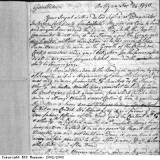Captains and traders
European and African traders had to work together, but did not necessarily trust each other. There are many stories of European captains enslaving the traders with whom they dealt. It was also quite common for African traders to play off Europeans against each other in order to get the best price for their slaves.
In the Public Record Office at Kew, London, there is a letter to James Rogers, a trader from Bristol. The letter is from the African Duke Ephraim, who was the leader of the Old Town, Old Calabar, in what is now Nigeria in West Africa. Written in 1789, Duke Ephraim complained that the captain of Rogers’ ship the Jupiter had kidnapped two of his canoemen. They were not for sale, and the Duke demanded their return. The Duke was hurt by this betrayal of the relationship between him and his trading partner Rogers, and threatened to make Bristol ships pay for it. He would make trade difficult for them.
There was also the question of whom to buy. Europeans had fixed and stereotyped ideas about the best slaves. They saw each ethnic group (or culture) in West Africa, as having different characters, such as hard-working, or lazy, and so on. The Bristol trader Isaac Hobhouse used the agents Arbuthnot and King to sell his slaves on the Caribbean island of Antigua. In a letter, pictured here, the agents asked Hobhouse to do the following:
“direct your vessells to the Gold Coast [in Ghana] or Widdaw, as Negroes from those places … will allways sell at Good Prices, when Bonny Negroes [from Bonny in the Bight of Benin] … are held in much Contempt …”.
The trader was instructed to buy Africans from Ghana as they had a better reputation than those from Bonny. They were seen as hard-working and reliable. These reputations were based on the stereotyping of different ethnic groups (or cultures). This reputation would affect the price that the slaves could be sold at and therefore the profit that could be made
The traders’ main aim was to buy healthy and young slaves. The written orders from the accounts book of a slave ship called the Africa give the captain, Thomas Baker, his instructions for buying slaves and the treatment of them on board. He was told to start trading at Cape Mount on the west coast of Africa… ‘and continue it all along to Annamaboe, buying all the healthy young negroes that offer as well ivory, gold and mellegella [pepper].’



